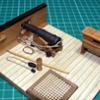-
Posts
5,924 -
Joined
-
Last visited
Content Type
Profiles
Forums
Gallery
Events
Everything posted by BANYAN
-
Ditto Eberhard: that looks very effective, and I defy anyone to manually create scale chain that small. cheers Pat
-
Welcome aboard Glen, great to see another modeller from down under come aboard. cheers Pat
-
Wow Steven, what a transformation from that 'tired' older model you started with. Your efforts (and drudgery) are paying dividends. cheers Pat
- 740 replies
-
- Tudor
- restoration
-
(and 4 more)
Tagged with:
-
What a voyage of epic proportions you have taken us on Glen. It has been a joy to follow-along on your many adventures. An excellent result and a display that I am sure that will be the subject of many discussions and perhaps a 'tot' or two. cheers Pat
-
Just found this Steven; I'll be following this, yet another very interesting build, with much interest. cheers Pat
- 508 replies
-
Impressive work Glen, I think you have a very near match for the ocean colour you were shooting for. If you go down the path of water from the bottle's mouth, perhaps some clear nylon fishing line CA'd to the mouth of the bottle would provide a starting framework/ligature for the water? cheers Pat
-
Nicely executed Dave; the scuppers look good. cheers Pat
- 143 replies
-
Big call Keith - I'll stay away from that debate - Luckily I stick to good ol' rum (Bundaberg preferably) cheers Pat
-
Up to your usual very high-quality joinery work Richard; slowly coming along very nicely. cheers Pat
-
You're welcome to the Fosters Glen but I will try to warn you off that exported 'dishwater' . That diorama is starting to look really good. cheers Pat
-
For a hull made from no plans that looks pretty good. Probably too late to add some additional filling/backing behind the ply to satisify those 'starving cows'; but if needed you can always glue a second layer in the 'holllows/flats to fill those areas out before sanding? cheers Pat
- 536 replies
-
- Quadrireme
- radio
-
(and 1 more)
Tagged with:
-
Ah so that's the trick - gradual grooming - puts paid to my 'shock and awe' approach Looking really good Ian, those line look really good; you must have put considerable effort into the fairing? cheers Pat
- 536 replies
-
- Quadrireme
- radio
-
(and 1 more)
Tagged with:
-
That is a very nicely detailed model; especially at the scale you are working at Eberhard. Impressive! cheers Pat
-
That's looking really good Steven, the sails and increasingly dense web of rigging is really adding interesting detail to show her off. Hat is 'doffed' for such great detail in such a small scale of working. cheers Pat
- 740 replies
-
- Tudor
- restoration
-
(and 4 more)
Tagged with:
-
Hi Glen, I am sure you understood I was simply 'stirring the porridge' so to speak BUT, will be tickled pink if you do. You are developing a very interesting diorama and presentation of your latest creation. cheers Pat
-
That's looking so good Glen; you could get a second job in movie model making. cheers Pat
About us
Modelshipworld - Advancing Ship Modeling through Research
SSL Secured
Your security is important for us so this Website is SSL-Secured
NRG Mailing Address
Nautical Research Guild
237 South Lincoln Street
Westmont IL, 60559-1917
Model Ship World ® and the MSW logo are Registered Trademarks, and belong to the Nautical Research Guild (United States Patent and Trademark Office: No. 6,929,264 & No. 6,929,274, registered Dec. 20, 2022)
Helpful Links
About the NRG
If you enjoy building ship models that are historically accurate as well as beautiful, then The Nautical Research Guild (NRG) is just right for you.
The Guild is a non-profit educational organization whose mission is to “Advance Ship Modeling Through Research”. We provide support to our members in their efforts to raise the quality of their model ships.
The Nautical Research Guild has published our world-renowned quarterly magazine, The Nautical Research Journal, since 1955. The pages of the Journal are full of articles by accomplished ship modelers who show you how they create those exquisite details on their models, and by maritime historians who show you the correct details to build. The Journal is available in both print and digital editions. Go to the NRG web site (www.thenrg.org) to download a complimentary digital copy of the Journal. The NRG also publishes plan sets, books and compilations of back issues of the Journal and the former Ships in Scale and Model Ship Builder magazines.





